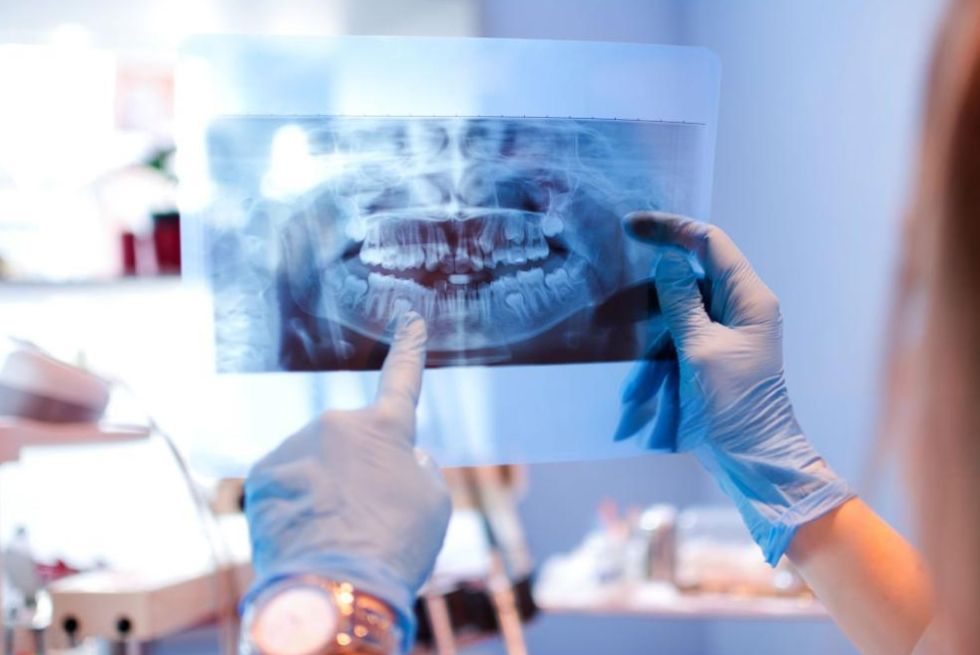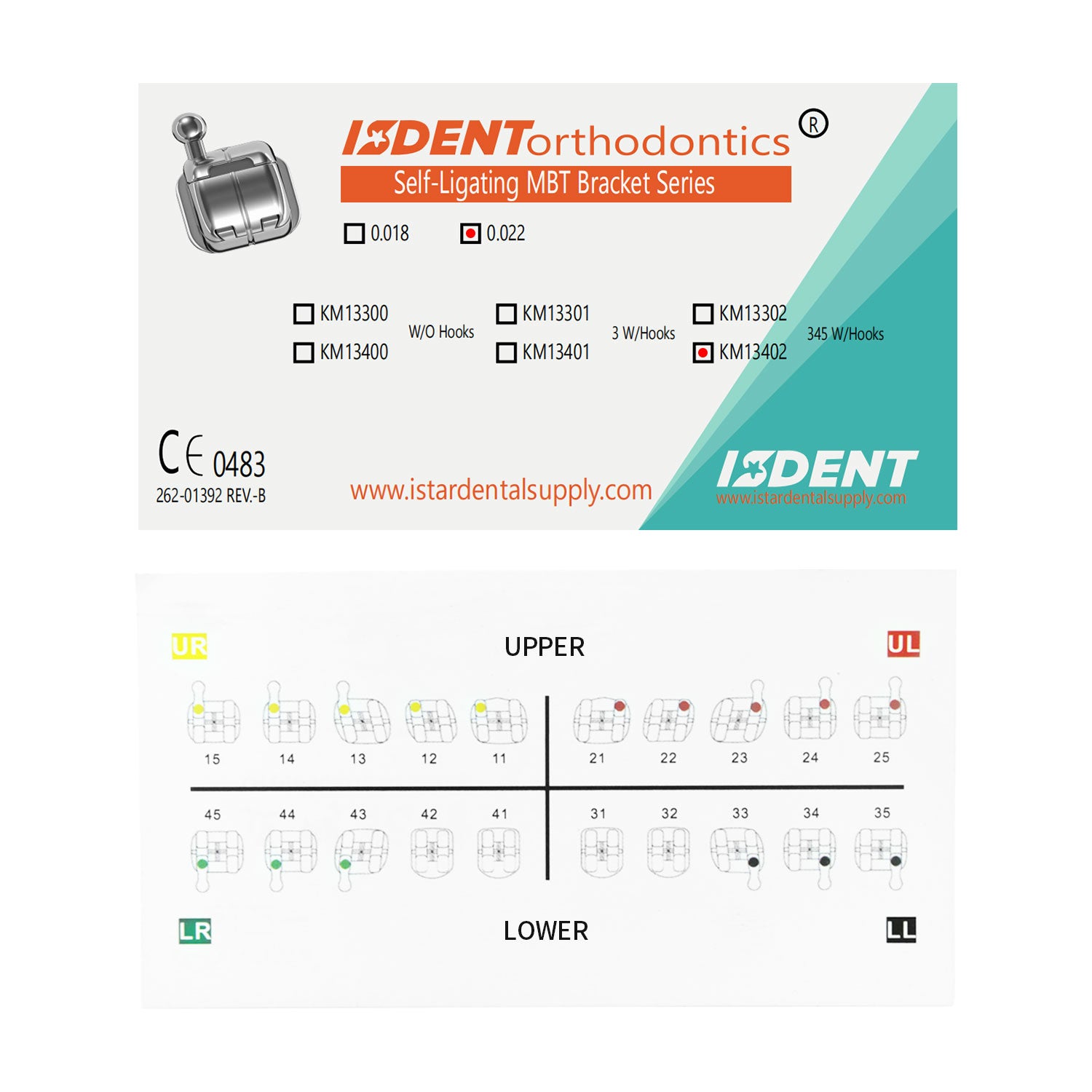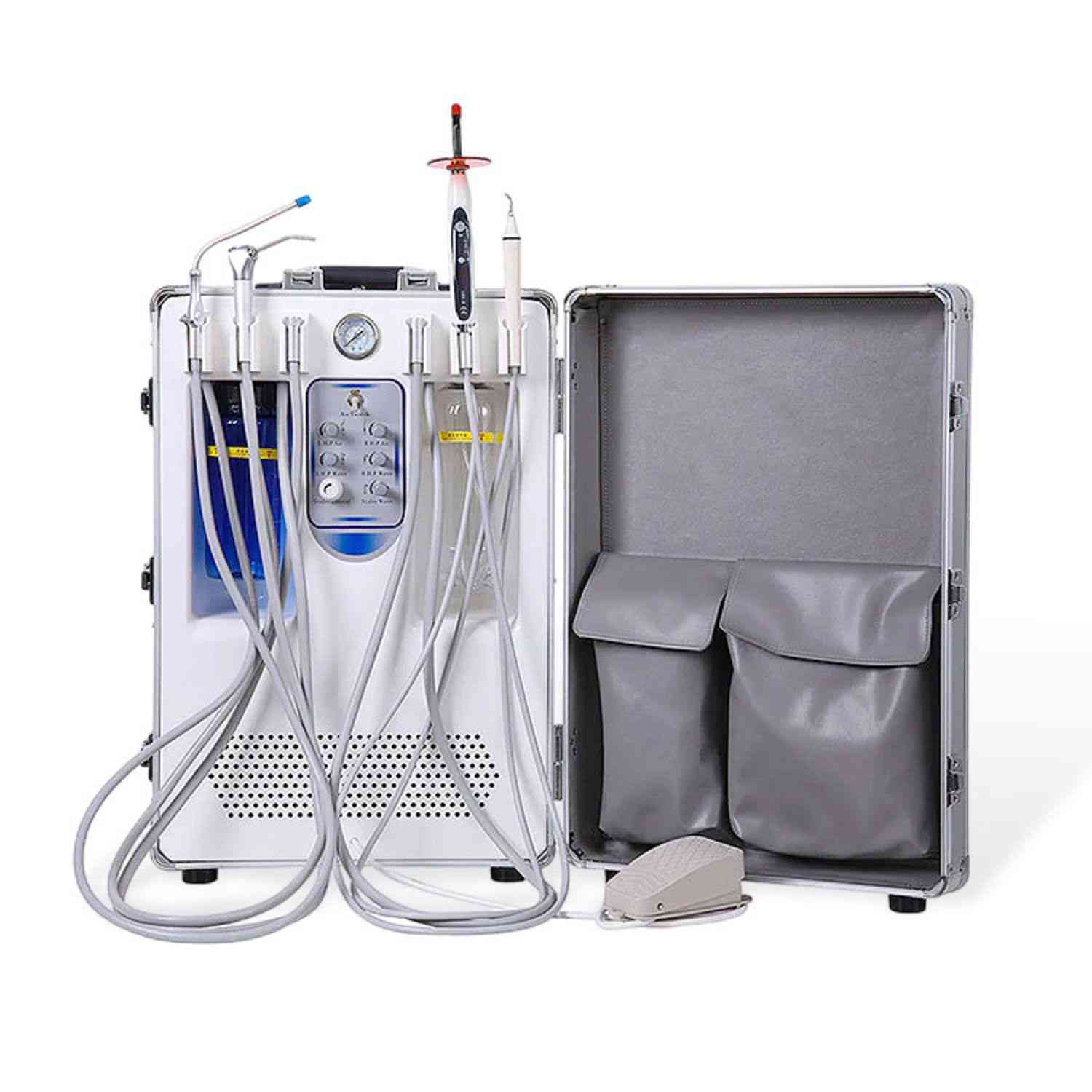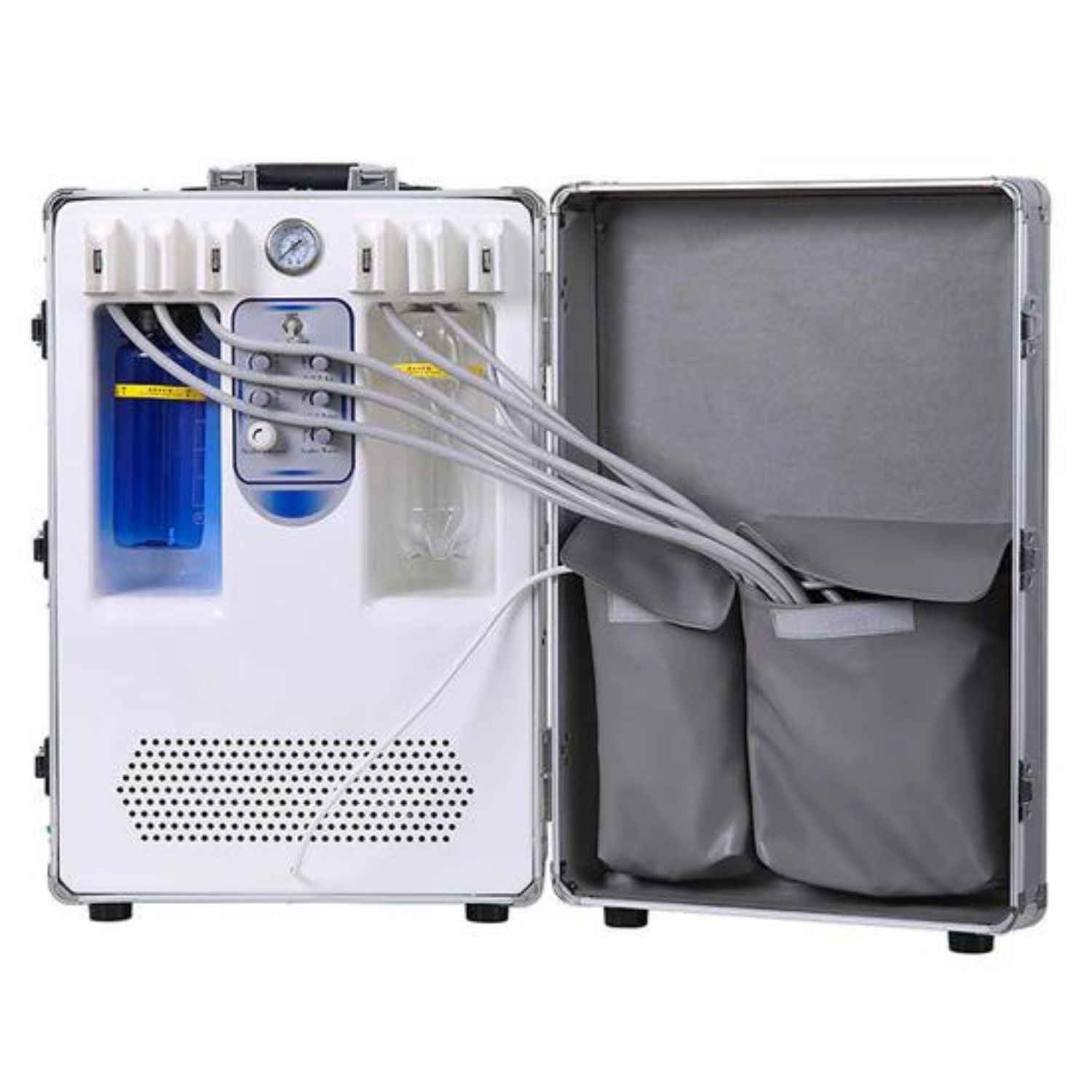كشف غموض الأشعة السينية للأسنان: دليل شامل لأخصائيي طب الأسنان
توفر هذه المقالة نظرة عامة مفصلة على مختلف أنواع الأشعة السينية للأسنان، واستخداماتها، وفوائدها، مُصمم خصيصًا لأطباء الأسنان، وعيادات الأسنان، ومختبرات الأسنان، ومستشفيات الأسنان، وكليات طب الأسنان. إنه كتاب لا غنى عنه لفهم الفروق الدقيقة تصوير الأسنان يُعدّ هذا الأمر بالغ الأهمية للتشخيص الدقيق، وتخطيط العلاج الفعال، وضمان رعاية مثالية للمرضى. بصفتنا شركة ISTAR لتوريدات الأسنان، فإننا ملتزمون بتقديم أفضل الخدمات ليس فقط جهاز الأشعة السينية للأسنان ولكن أيضا المعرفة اللازمة لاستخدامها بشكل فعال.
1. ما هي الأنواع الرئيسية لأشعة الأسنان؟
الأشعة السينية للأسنان تُعدُّ أدوات تشخيصية أساسية في طب الأسنان الحديث. فهي تُتيح لأطباء الأسنان رؤية واضحة للأسنان والعظام والأنسجة المحيطة بها، مما يُمكّنهم من اكتشاف المشاكل غير المرئية أثناء الفحص الفموي الدوري. هناك نوعان من الأنواع الرئيسية لطب الأسنان الأشعة السينية: داخل الفم وخارجه. الأشعة السينية داخل الفم هي الأكثر نوع شائع من الأشعة السينية للأسنان، حيث فيلم الأشعة السينية يتم وضعه داخل الفم. أما الأشعة السينية خارج الفم، فيتم وضعها خارج الفم.
ال ثلاثة أنواع رئيسية من طب الأسنان الأشعة السينية التي تندرج تحت هذه الفئات هي أشعة الجناح، والأشعة فوق البنفسجية، والأشعة البانورامية. كل منها نوع من الأشعة السينية يخدم غرضًا فريدًا. تُركز أشعة Bitewing السينية على تيجان الأسنان العلوية والسفلية، وتُستخدم بشكل أساسي للكشف عن التسوسات بين الأسنان والتغيرات في كثافة العظام. ناجم عن أمراض اللثة. الأشعة السينية حول الذروة إظهار السن بالكامل، من التاج إلى الجذر و العظم المحيط، مفيدة لتحديد مشاكل الجذور والخراجات والأسنان المتأثرة. الأشعة السينية البانورامية توفير رؤية واسعة للفم بأكمله، بما في ذلك جميع الأسنان في العلوي والسفلي الفكين، وتستخدم لتقييم أسنان العقل، ومشاكل الفك، والتخطيط للعلاجات مثل زراعة الأسنان.
اختيار الصحيح نوع من الأشعة السينية للأسنان يعتمد ذلك على الاحتياجات التشخيصية المحددة للمريض. تقدم ISTAR Dental Supply مجموعة من مستشعر RVG للأسنان، والتي تسمح لطبيب الأسنان بتلقي صور الأشعة السينية عالية الجودة وسهلة القراءة.
2. لماذا تعتبر الأشعة السينية Bitewing مهمة لأطباء الأسنان؟
أشعة سينية لعضة الجناح تعتبر رائعة لتوضيح تيجان الأسنان الخلفية وارتفاع العظم بين الأسنان. أطباء الأسنان تُستخدم أجهزة أجنحة العض بشكل روتيني للكشف عن تسوس الأسنان القريبة (التجاويف بين الأسنان)، والتي غالبًا ما تكون غير مرئية للعين المجردة. كما تُستخدم لتقييم ملاءمة ترميمات الأسنان، مثل التيجان و حشوات الأسنان، ومراقبة مستويات العظام بحثًا عن علامات أمراض اللثة.
ال الأشعة السينية يتم ذلك عن طريق جعل المريض يعض على جهاز استشعار صغير أو حامل فيلم، والذي يحمل فيلم الأشعة السينية في مكانه. شعاع الأشعة السينية يتم بعد ذلك توجيهها عبر الأسنان، مما يؤدي إلى إنشاء صورة توضح الأسنان العلوية والسفلية في منطقة واحدة. غالبًا ما تكون الأشعة السينية لأجنحة العض جزء من طب الأسنان العادي الفحوصات، مما يسمح لأطباء الأسنان بتحديد المشاكل في وقت مبكر وتقديم العلاج في الوقت المناسب العناية بالأسنانتدرك شركة ISTAR Dental Supply مدى أهمية الصورة الواضحة والدقيقة لطبيب الأسنان، وبالتالي، تقدم جودة ألواح الفوسفور لطب الأسنان، والتي تسمح لأطباء الأسنان بالحصول على صور دقيقة.
3. كيف تساعد الأشعة السينية حول قمة الجذر في تشخيص مشاكل الجذر؟
أ الأشعة السينية حول الذروة يظهر السن بأكمله، من التاج إلى قمة الجذر، بالإضافة إلى العظم المحيط. عادةً ما تكون الأشعة السينية حول الذروة تستخدم عندما طبيب أسنان يشتبه في وجود مشكلة أسفل خط اللثة أو في عظم الفك. الأشعة السينية تساعد تشخيص مشاكل مثل التهابات قناة الجذر، والخراجات، والأكياس، والأورام، و الأسنان المتأثرة.
توفر الأشعة السينية حول القمة معلومات مفصلة عن صحة الأسنان الفردية والهياكل الداعمة. وهي ضرورية لتخطيط علاج لب الأسنان (علاج قناة الجذر)، وتقييم نجاح العلاجات السابقة، وتقييم فقدان العظام حول أسنان محددة. ال الأشعة السينية يتم ذلك عن طريق وضع جهاز استشعار أو فيلم داخل الفم، بالتوازي مع السن المراد فحصه. الأشعة السينية يتم استخدامه لالتقاط صورة كاملة للسن وجذره.
4. ما هي الأشعة السينية البانورامية ومتى يتم استخدامها؟
أ الأشعة السينية البانورامية هو الأشعة السينية خارج الفم الذي يلتقط رؤية شاملة للفم بأكمله، بما في ذلك جميع الأسنان، الفك العلوي والسفليوالمفاصل الفكية الصدغية (TMJ) والجيوب الأنفية. على عكس الأشعة السينية داخل الفم، جهاز الأشعة السينية يدور حول رأس المريض أثناء التعرض.
هذا نوع من الأشعة السينية مفيد بشكل خاص لـ:
- تقييم وضعية أسنان العقل.
- تقييم مشاكل مفصل الفك (TMJ).
- الكشف عن وجود الأكياس والأورام أو أي تشوهات أخرى في عظم الفك.
- التخطيط للعلاج التقويمي.
- التخطيط لزراعة الأسنان.
- تقييم الإجمالي صحة الأسنان والتنمية.
أ بانورامي الصورة تسمح طبيب أسنان لرؤية البنية الفموية بأكملها في صورة واحدة، مما يوفر منظورًا أوسع من الأشعة السينية داخل الفم. تدور الآلة حول رأسك، لالتقاط رؤية كاملة.
5. ما هي استخدامات الأشعة السينية الإطباقية؟
الأشعة السينية الإطباقية أقل نوع شائع من الأشعة السينية للأسنان، مشابهة لأشعة إكس لعض الأجنحةومع ذلك، فهي أكبر حجمًا وتُظهر الصورة بأكملها قوس الأسنان في أي منهما الفك العلوي أو السفلي. يتم استخدام هذه الأشعة السينية لـ:
- الكشف عن غير المنفجر أو الأسنان المتأثرة (خاصة عند الأطفال).
- تحديد الأسنان الزائدة (الإضافية).
- تقييم تطور الفكين عند الأطفال.
- الكشف عن الأكياس أو الخراجات أو أي نمو آخر في الحنك أو أرضية الفم.
- تحديد موقع الأجسام الغريبة.
- تقييم كسور الأسنان الأمامية أو الفك.
يقوم المريض بعض جهاز استشعار أو فيلم أكبر، مما يسمح طبيب أسنان لمشاهدة كامل هياكل الأسنان للفك العلوي أو السفلي في صورة واحدة.
٦. هل تصوير الأسنان بالأشعة السينية آمن؟ فهم التعرض للإشعاع.
إن القلق المشترك بين المرضى هو سلامة الأشعة السينية للأسنان بسبب التعرض للإشعاع. بينما الأشعة السينية هل تنطوي على كمية صغيرة من الإشعاع، حديث أشعة الأسنان لقد أدت التكنولوجيا إلى تقليل عدد الوفيات بشكل كبير كمية الإشعاع مطلوب لإنتاج صور عالية الجودة. الأشعة السينية الرقمية، على وجه الخصوص، استخدم بشكل كبير إشعاع أقل من الأشعة السينية التقليدية المعتمدة على الأفلام.
يتبع أطباء الأسنان مبدأ ALARA (أقل ما يمكن تحقيقه بشكل معقول) لتقليل التعرض للإشعاع. ويشمل ذلك:
- استخدام أسرع مستقبل للصورة (فيلم أو مستشعر رقمي) ممكنًا.
- استخدام المحاذاة المناسبة لتقييد شعاع الأشعة السينية إلى منطقة الاهتمام.
- استخدام مآزر الرصاص وأطواق الغدة الدرقية لحماية المرضى.
- إجراء الأشعة السينية فقط عند الضرورة للتشخيص وتخطيط العلاج.
فوائد الأشعة السينية للأسنان في الكشف والتشخيص مشاكل الأسنان تفوق بكثير المخاطر البسيطة المرتبطة بـ إشعاعكما تقدم شركة ISTAR Dental Supply أيضًا ماسح PSP لتقليل كمية الإشعاع المطلوبة لتصوير الأسنان بالأشعة السينية.
7. كيف تختلف الأشعة السينية الرقمية عن الأشعة السينية التقليدية؟
طب الأسنان الرقمي لقد أحدثت الأشعة السينية ثورة تصوير الأسنان من خلال تقديم العديد من المزايا مقارنة بالطرق التقليدية أشعة سينية للأفلام:
| ميزة | الأشعة السينية الرقمية | الأشعة السينية للأفلام |
|---|---|---|
| التعرض للإشعاع | انخفاض كبير (حتى 80٪ تخفيض) | أعلى |
| اكتساب الصور | فوري | يتطلب معالجة كيميائية (يستغرق وقتا طويلا) |
| جودة الصورة | يمكن تعزيزها والتلاعب بها | صورة ثابتة |
| التخزين والاسترجاع | تخزين إلكتروني سهل | يتطلب مساحة تخزين مادية |
| التأثير البيئي | لا مواد كيميائية، صديق للبيئة | التخلص من النفايات الكيميائية |
الأشعة السينية الرقمية استخدم مستشعرًا بدلًا من الفيلم لالتقاط الصورة. يرسل المستشعر الصورة مباشرةً إلى جهاز كمبيوتر، حيث يمكن عرضها وتحسينها وتخزينها ومشاركتها إلكترونيًا. هذا يُلغي الحاجة إلى المعالجة الكيميائية، ويُقلل وقت الانتظار، ويُسهّل إدارة الصور.
8. دور الأشعة السينية في تخصصات طب الأسنان المختلفة.
الأشعة السينية للأسنان لها أهمية كبيرة في مختلف تخصصات طب الأسنان:
- طب الأسنان العام: الأشعة السينية تساعد في الفحوصات الروتينية ل يكشف تجاويف، مرض في اللثة، وغيرها من الأشياء الشائعة مشاكل الأسنان.
- طب لب الأسنان: قمة الرأس تعتبر الأشعة السينية ضرورية لتشخيص وعلاج مشاكل قناة الجذر.
- تقويم الأسنان: بانورامي ويتم استخدام الأشعة السينية الرأسية لتقييم محاذاة الأسنان والفك والتخطيط للعلاج.
- جراحة الفم: الأشعة السينية يتم استخدامها لتقييم الأسنان المتضررة، والتخطيط لخلعها، وتقييم بنية العظام للزرعات.
- طب اللثة: الأشعة السينية المساعدة في مراقبة فقدان العظام المرتبط مرض في اللثة.
- طب الأسنان التعويضي: الأشعة السينية يتم استخدامها لتقييم حالة الأسنان والعظام قبل وضع التيجان أو الجسور أو أطقم الأسنان.
- طب أسنان الأطفال: يتم استخدام الأشعة السينية لتصور ومراقبة تطور وصحة أسنان وفكين الأطفال.
- زراعة الأسنان: طبيب أسنانالأشعة السينية يقدم صورًا حيوية لبنية العظام، مما يساعد في التخطيط لزراعة الأسنان.
القدرة على الأشعة السينية لكشف المخفي هياكل الأسنان يجعلها أداة لا غنى عنها للتشخيص الدقيق وتخطيط العلاج في جميع مجالات طب الأسنان.
9. اختيار جهاز الأشعة السينية المناسب لعيادتك.
اختيار الحق جهاز الأشعة السينية للأسنان يُعدّ قرارًا هامًا لأي عيادة أسنان. ضع في اعتبارك العوامل التالية:
- نوع الأشعة السينية المطلوبة: حدد ما إذا كنت بحاجة إلى داخل الفم، أو خارج الفم، أو كليهما.
- الرقمي مقابل الفيلم: توفر الأنظمة الرقمية العديد من المزايا، بما في ذلك الإشعاع المنخفض، والتقاط الصور بشكل أسرع، وإدارة الصور بشكل أسهل.
- جودة الصورة: ابحث عن نظام ينتج صورًا واضحة وعالية الدقة.
- سهولة الاستخدام: اختر نظامًا سهل الاستخدام وبديهيًا لموظفيك.
- راحة المريض: خذ بعين الاعتبار الميزات التي تعمل على تعزيز راحة المريض، مثل مسند الرأس المريح والإعدادات القابلة للتعديل.
- يكلف: قم بتقييم الاستثمار الأولي، وكذلك التكاليف المستمرة مثل الصيانة والإمدادات.
- متطلبات المساحة: تأكد من أن الجهاز يناسب مساحة التدريب الخاصة بك بشكل مريح.
- الخدمة والدعم فكر فيما إذا كان البائع يقدم خدمة دعم عالية الجودة، أو يوفر قطع غيار.
شركة ISTAR Dental Supply، كشركة رائدة جهاز الأشعة السينية للأسنان يقدم مصنعنا مجموعة واسعة من أحدث أجهزة الأشعة السينية لتلبية مختلف احتياجات أطباء الأسنان. صُممت أجهزتنا لتحقيق الأداء الأمثل وجودة الصورة وسلامة المرضى.
10. ISTAR Dental Supply: شريكك في التصوير المتقدم للأسنان.
في ISTAR Dental Supply، نحن ندرك الدور الحاسم الذي الأشعة السينية للأسنان اللعب في تقديم ممتاز العناية بالأسناننحن ملتزمون بتزويد محترفي طب الأسنان بمنتجات عالية الجودة وموثوقة وبأسعار معقولة أشعة الأسنان المعدات. نحن نقدم أفضل أنواع أجهزة الأشعة السينية للأسنان، من خلال دمج أحدث التقنيات التي يستخدم إشعاعًا أقلكما نقدم أيضًا حلولاً لضمان قدرتك على توفير تجربة سلسة وآمنة لمرضاك.
تشمل مجموعة منتجاتنا ما يلي:
نحن نؤمن ببناء شراكات طويلة الأمد مع عملائنا، وتقديم الدعم المستمر، ومساعدتهم على البقاء في طليعة تصوير الأسنان التكنولوجيا. تواصل معنا اليوم لمعرفة المزيد عن منتجاتنا وكيف يمكننا مساعدتك في تحسين ممارساتك.
الأسئلة الشائعة:
ما هي أكثر أنواع الأشعة السينية للأسنان شيوعًا؟
الأكثر أنواع شائعة من الأشعة السينية للأسنان الأشعة السينية هي أشعة عض الجناح، والأشعة السينية حول الذروة، والأشعة السينية البانورامية.
كم مرة يجب إجراء الأشعة السينية للأسنان؟
تردد الأشعة السينية للأسنان يعتمد ذلك على الاحتياجات الفردية، وتاريخ صحة الفم، وعوامل الخطر. طبيب أسنان سيتم تحديد الجدول المناسب.
هل الأشعة السينية للأسنان آمنة للأطفال؟
نعم، الأشعة السينية للأسنان آمنة للأطفال. كمية الإشعاع الاستخدام محدود، وفوائد الكشف المبكر عن مشاكل الأسنان تفوق مخاطرها. يتخذ أطباء أسنان الأطفال احتياطات خاصة لتقليل التعرض.
ما هو الفرق بين الأشعة السينية داخل الفم والأشعة السينية خارج الفم؟
في الأشعة السينية داخل الفم يتم وضع الفيلم أو المستشعر داخل الفم، بينما في الأشعة السينية خارج الفم يتم وضع الفيلم أو المستشعر خارج الفم.
هل يجوز للحامل إجراء أشعة الأسنان؟
في حين أنه من المستحسن عمومًا تأجيل الأشعة السينية الاختيارية أثناء الحمل، إلا أن هناك بعض الأمور الأساسية التي يجب مراعاتها عند إجراء الأشعة السينية. الأشعة السينية للأسنان يمكن تناوله مع حماية مناسبة (مئزر رصاصي وطوق الغدة الدرقية). أبلغ طبيبك دائمًا طبيب أسنان إذا كنت حاملاً أو تعتقدين أنك حامل.
هل أشعة الأسنان مؤلمة؟
لا، الأشعة السينية للأسنان غير مؤلمة. قد تشعر بانزعاج طفيف عند وضع المستشعر أو الفيلم في فمك، لكن الإجراء نفسه سريع ولا يسبب أي ألم.
النقاط الرئيسية:
- الأشعة السينية للأسنان ضرورية للكشف عن مشاكل الأسنان الخفية.
- هناك مختلفة أنواع الأشعة السينية للأسنان، كل منها يخدم غرضًا محددًا.
- الأشعة السينية الرقمية تقدم مزايا كبيرة مقارنة بالأشعة السينية للأفلام التقليدية.
- التعرض للإشعاع من أشعة الأسنان هو الحد الأدنى ويعتبر آمنًا.
- اختيار الصحيح جهاز الأشعة السينية يعد أمرًا بالغ الأهمية لنجاح ممارستك.
- ISTAR Dental Supply هي شركة موثوقة لتوفير منتجات عالية الجودة أشعة الأسنان معدات.
اتصل بـ ISTAR Dental Supply اليوم لجميع احتياجاتك تصوير الأسنان احتياجاتك. نحن شريكك في تقديم خدمات استثنائية العناية بالأسنان.










